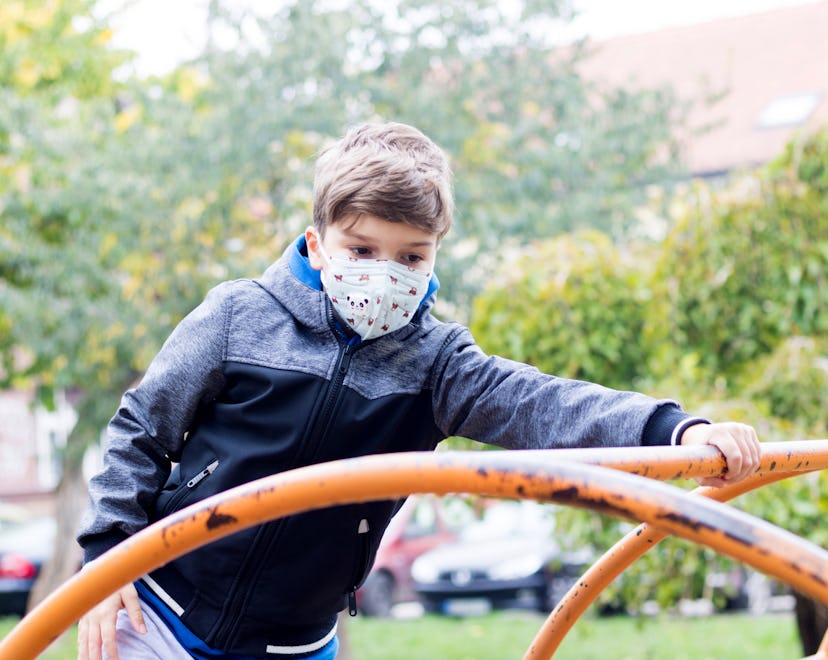Coronavirus

How To Make Your KN95 Masks Last A Little Bit Longer Than One Wear
Experts share how to wear and preserve your family’s N95 and KN95 masks.
This particular phase of the pandemic may feel like deja vu all over again, but as many experts have pointed out, we have tools for managing the omicron surge that we didn’t have in the earlier stages of Covid. Chief among these are vaccines, of course, but we also have at-home rapid tests and better information about the most effective masks. Cloth masks made sense when we were first learning to protect ourselves, but now high quality KN95 and N95 respirators are recommended for everyone, including children. These masks can be costly — and aren’t always readily available — so knowing how to reuse a KN95 or N95 safely is essential.
What Is A KN95 & N95 Mask?
KN95 and N95 “masks” are actually called respirators. They are tight-fitting mouth and nose coverings made from synthetic material that filter out 95% “airborne particles,” hence the 95 in the name. N95s are approved by the National Institute for Occupational Safety and Health (NIOSH), a part of the CDC, while KN95s meet international standards. They’re similar, but only N95s are approved for health-care use in the United States.
Can Kids Wear N95 & KN95 Masks?
With respirators in particular, fit should be a top priority, so adult-sized N95 and K95s won’t work for kids. There are brands that design KN95 and N95 models specifically for children.
For younger kids who may struggle to keep a mask on or touch their face a lot, a sturdy, protective washable mask that fits them well may make more sense. You should consult your healthcare providers to help make the best decisions for you and your family.
Can You Reuse An KN95 Or N95 Mask?
Technically speaking, N95 and KN95s are intended for one-time use. When PPE supplies are running low — as they were early in the pandemic — the CDC says “crisis capacity strategies” may allow for some reuse practices for certain individuals.
Adults and kids not working in a high risk health-care setting can probably get a bit more use out of their masks. “If handled carefully, they can probably be reused as long as the mask has no visible damage and maintains a good seal or fit next to [a person’s] face,” says Dr. Emily P. Hyle, and M.D. with the division of infectious diseases at Massachusetts General Hospital. “The biggest risk is that the mask no longer has a tight seal, or has some breakdown in the fibers such that it no longer attains 95% filtration. Then, the person thinks that they have maximum protection while wearing the mask, but they don’t.”
Another potential drawback, Hyle tells Romper, is more frequent touching of the mask: “There is also a small risk in becoming infected from viral particles on the outside of the mask when handling [it].”
Is there any way to preserve the life of your respirator? Unfortunately an N95 or KN95 mask can’t be cleaned like a cloth mask. Your best bet is to combine an N95 with other mitigation strategies, such as social distancing.
And if you are reusing your KN95 or N95, Hyle tells Romper, “You do need to be careful when putting the mask on or removing it — there can be some viral particles on the outside, so wash your hands after touching the mask if you have reused it.”
When To Toss Your KN95 & N95 Masks
Traditionally, they’re used once, then discarded, so “we don’t have great data on this,” says Hyle.
Remember, a major feature of a KN95 and N95 mask is its fit; respirators are supposed to fit tightly around the face, eliminating cracks and gaps that might allow for particles to pass. If the mask starts to gap for any reason, it’s no longer at maximum efficiency. So if you spot your kid yanking at an N95 because it keeps drooping, it’s not the best choice.
Another major red flag is if the N95 or KN95 is wet or dirty. If you’re trying to preserve your kid’s respirator masks, avoid letting them wear it during water play or for outside exercise where they might be breathing heavily into the mask.
Though N95 and KN95 coverings are meant for single-use, if you’ve worn it over five times, said the CDC, then it’s definitely time to dispose of it. Remember, these coverings filter out particles so as they get worn, they become “clogged” and need to be thrown out.
If you want to refresh your supplies, check on which N95 and KN95 respirators are NIOSH approved. There are lots of counterfeit respirators on the market and you want one with the NIOSH stamp of approval.
Expert:
Emily P. Hyle, M.D., MSc, Division of Infectious Diseases, Massachusetts General Hospital, assistant professor of medicine, Harvard Medical School.